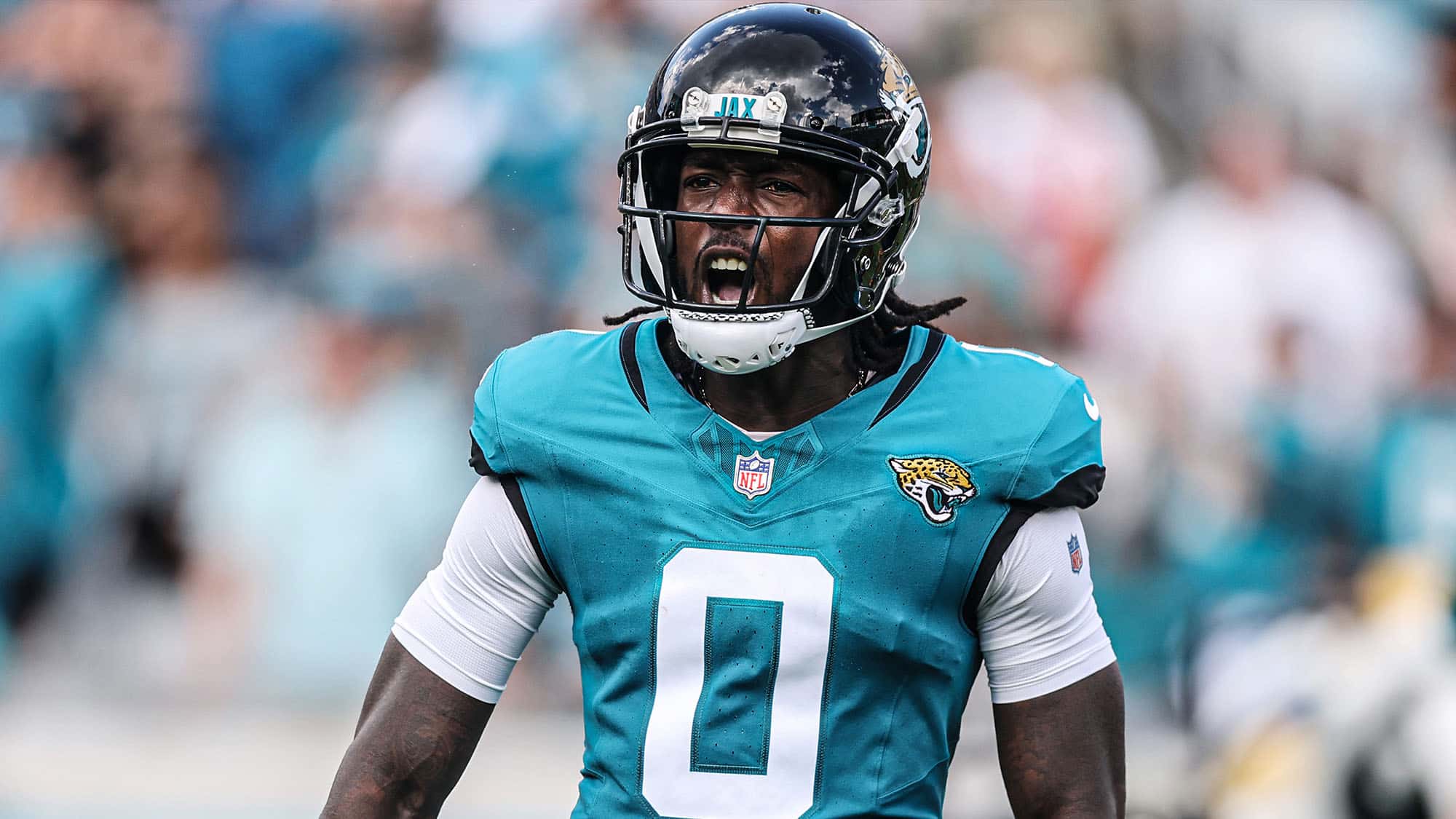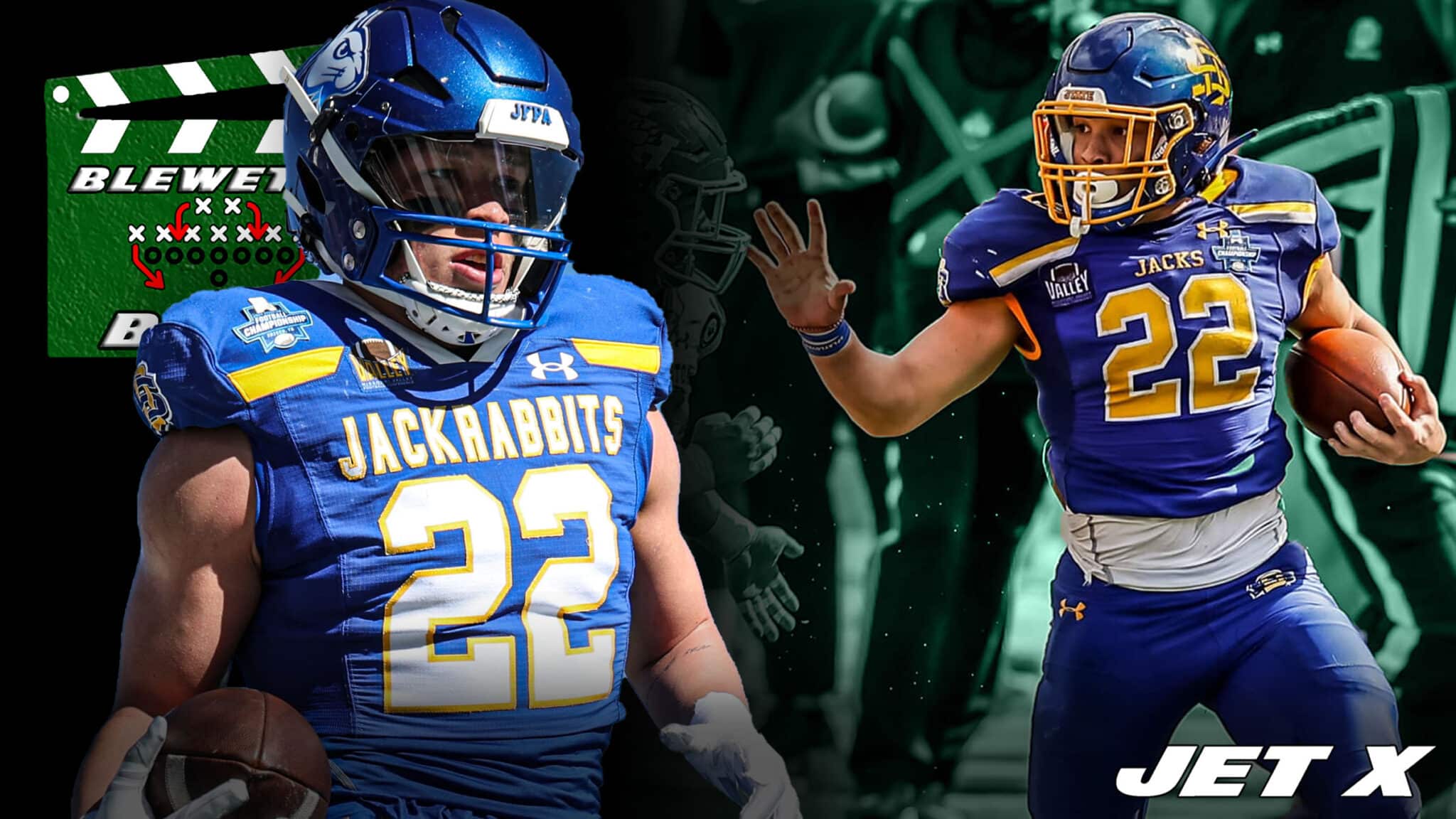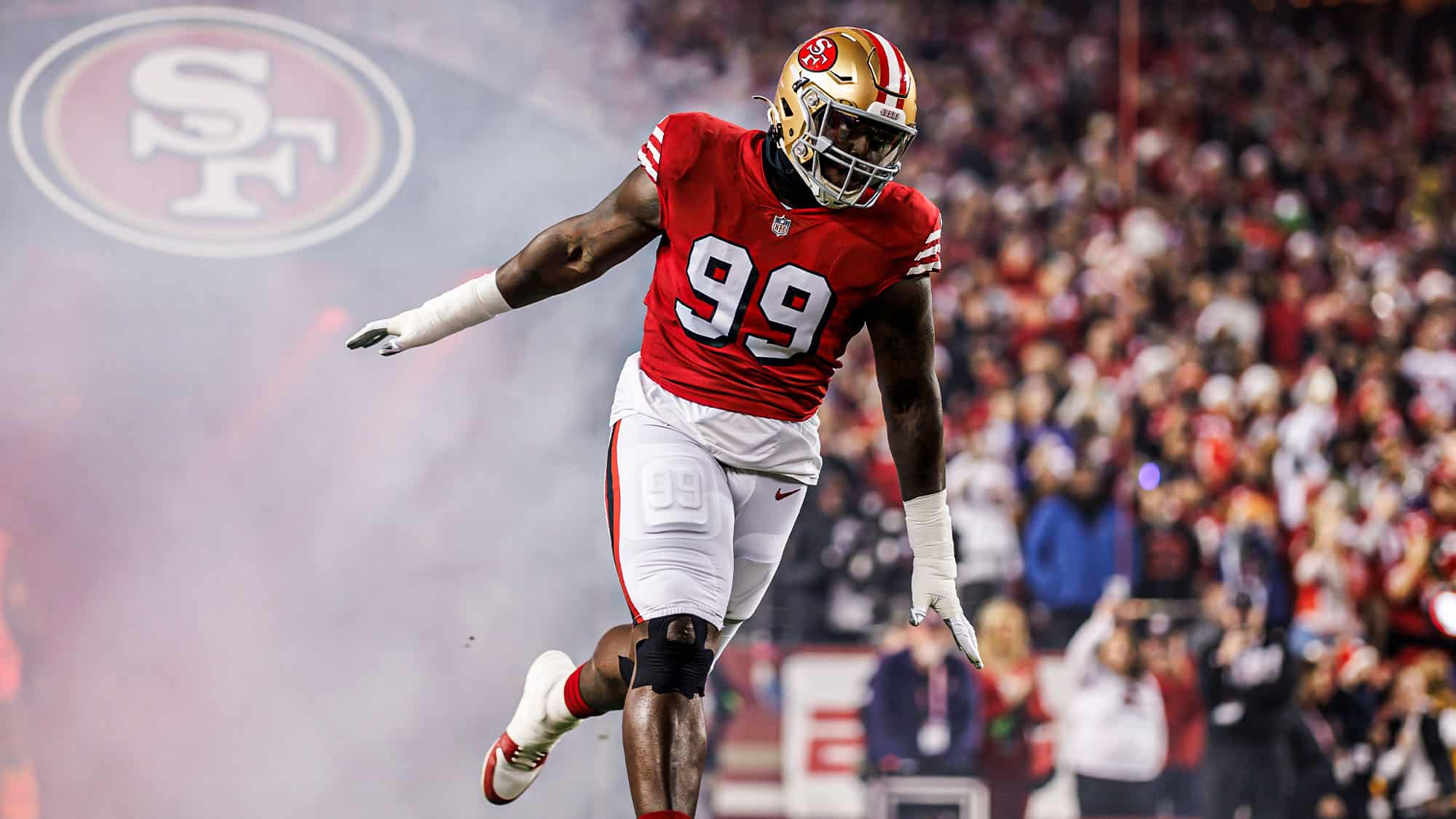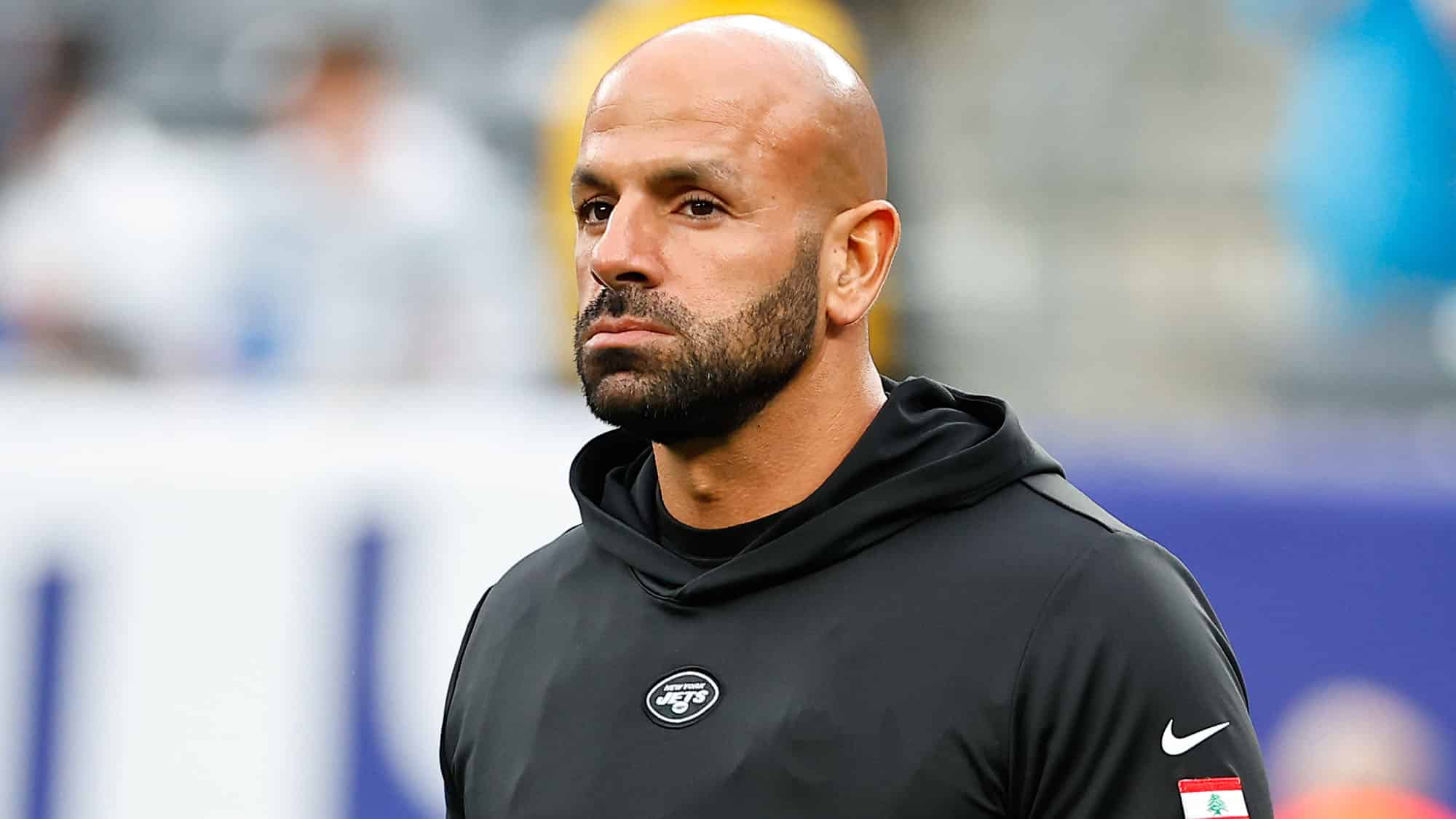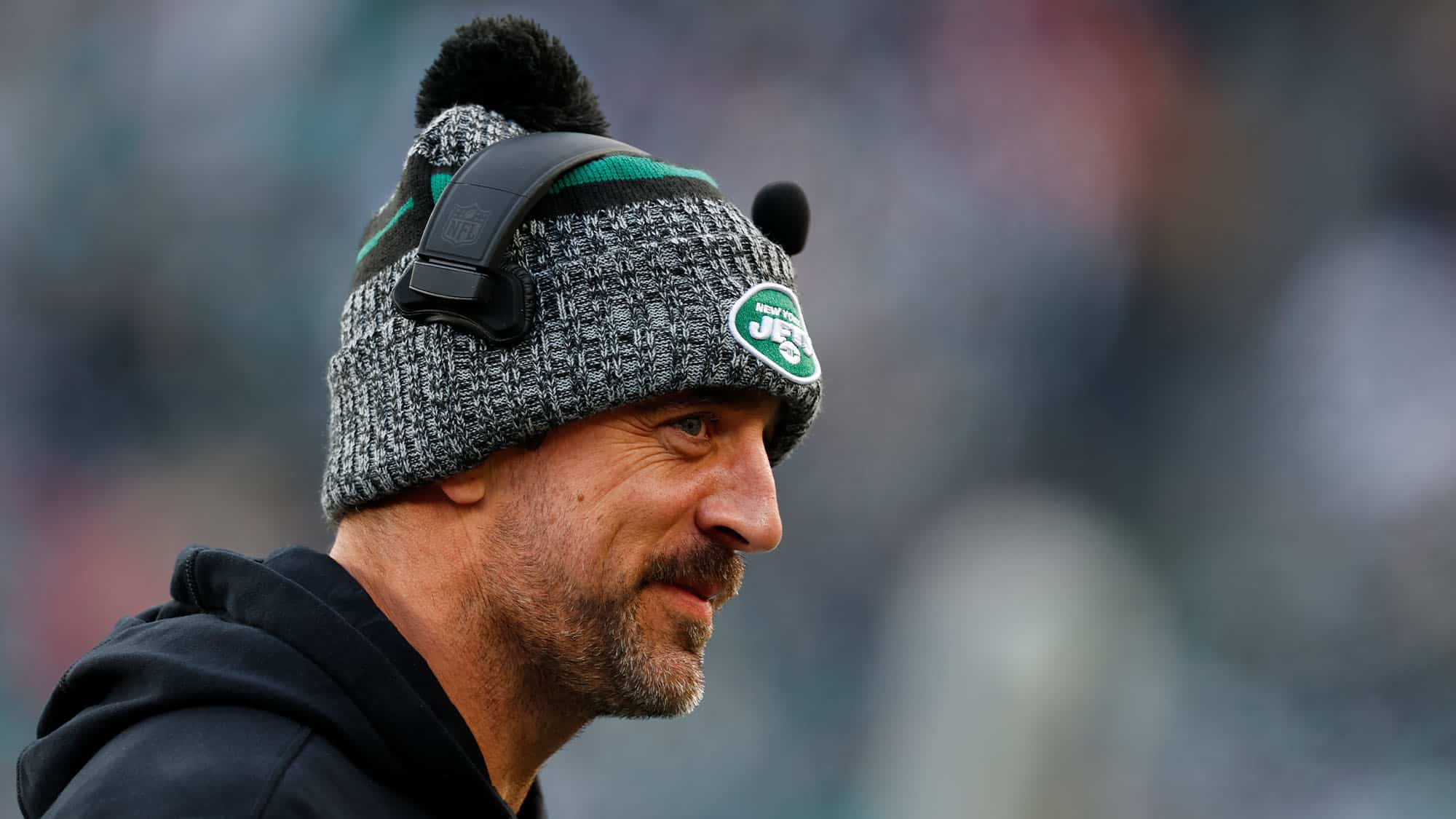The New York Jets need a threatening presence opposite Garrett Wilson
One of the New York Jets’ most crushing weaknesses on offense was the lack of depth at wide receiver behind Garrett Wilson. With no other wide receivers on the Jets’ roster who posed even the smallest of a threat, opposing defenses happily double-teamed Wilson all game long and enjoyed great success with the strategy.
To fully unleash Wilson and the entire passing game, New York needs to find a quality wide receiver who demands enough respect to divert attention from Wilson.
The Jets are expected to go star-hunting at this position. Davante Adams is the most popular name due to his connections, although he remains under contract with the Raiders, who did not seem eager to trade him at the deadline. Free agents like Tee Higgins, Mike Evans, and Michael Pittman Jr. have also been discussed, although each of those three players has a strong chance of remaining with their current team.
That could push the Jets toward Calvin Ridley, whom they were interested in trading for two years ago. Unlike the other household names on the market, Ridley could have a good chance of finding a new home.
Ridley’s first season in Jacksonville did not go as hoped, and on top of that, the Jaguars will lose significant draft capital if they sign Ridley to a contract extension. Per the terms of the trade that sent Ridley to Jacksonville, Atlanta is due to receive a conditional fourth-round pick from Jacksonville in this year’s draft; that pick will upgrade to a second-rounder if Ridley signs an extension with Jacksonville.
Would Ridley make sense for the Jets?
Jets free agent profiles:
Basic info
- Age: 29.1
- Height: 6-foot-1
- Weight: 190 pounds
- College: Alabama
- Experience: 6 years (Drafted Round 1, Pick 26 by Atlanta in 2018)
- Teams: Falcons (2018-22), Jaguars (2022-present)
- Previous contract: Accepted fifth-year option for $11.1M
Measurables
- Data from 2018 Combine (via Mockdraftable)
- Percentiles among all-time wide receiver prospects
- Height: 6’0½” (36th percentile)
- Weight: 189 pounds (21st)
- Wingspan: 75.75in (41st)
- Arm length: 31.625in (40th)
- Hand size: 9.125in (30th)
- 40-yard dash: 4.43s (76th)
- Vertical jump: 31in (7th)
- Broad jump: 110in (2nd)
- 3-cone drill: 6.88s (66th)
- 20-yard shuttle: 4.41s (12th)
- Bench press: 15 reps (55th)
Ridley earned a Relative Athletic Score (RAS) of 5.12/10.
Role
Despite Christian Kirk’s breakout season as Jacksonville’s No. 1 receiver in 2022, Ridley immediately came in and challenged Kirk for the top spot on the depth chart. They essentially held equal status in the Jaguars’ offense.
In his first season as a Jaguar, Ridley started all 17 of Jacksonville’s games. Kirk played in 12 games, suffering a season-ending core muscle injury one snap into the 12th game.
Over the 11 games in which both players were healthy, Ridley edged out Kirk for the No. 1 spot in terms of snaps, playing 84% of the snaps versus Kirk’s 77%. However, Kirk took the advantage in targets, seeing 84 of them (7.6 per game) to Ridley’s 76 (6.9 per game).
Jacksonville predominantly utilized Ridley on the outside. Ridley lined up out wide on 81.4% of his pass-game snaps and in the slot on 18.6%. This lines up closely with his career norms, as he lined up out wide 83.7% of the time in Atlanta.
The Jaguars used Ridley as a downfield threat. His average depth-of-target (ADOT) was 13.9 yards, ranking 13th among 70 qualified wide receivers. Ridley tied for fourth at the position with 32 deep targets (20+ yards downfield) and was second with 52 intermediate targets (10-19 yards). Comparatively, he was 34th with 40 short targets (0-9 yards).
Per NFL Next Gen Stats, here is a look at the distribution of Ridley’s route tree in 2023 based on the percentage of his routes run (all routes, not just targeted routes) that were classified as each route type.
2023 performance
Disappointing efficiency
Ridley ended up with a decent stat line on paper, finishing with 76 receptions for 1,016 yards and eight touchdowns. But when you consider it took him 17 games, 136 targets, and the fifth-most routes run of any wide receiver (601) to get those numbers, he wasn’t actually an efficient player. This was a disappointing outcome for Ridley after how efficient he was in Atlanta.
In 2023, Ridley finished with 7.5 yards per target, a 55.9% catch rate, and a 48.5% success rate. These are all career lows excluding a shortened five-game season in 2021. Overall, in 49 games for Atlanta, he averaged 8.8 yards per target, a 65.3% catch rate, and a 54.5% success rate.
While Ridley caught eight touchdowns, there were also four interceptions thrown in his direction, which is part of the reason why Ridley generated an 89.7 passer rating when targeted. This ranked 44th out of 70 qualified wide receivers (min. 60 targets). It was also much lower than Kirk’s 104.6, which ranked 21st.
Major struggles without Christian Kirk
Ridley had to play six games without Kirk and struggled mightily in the featured role.
Here is a comparison of Ridley’s production with and without Kirk.
- Games 1-11 (with Kirk): 6.9 targets per game, 60.3 yards per game, 61.8% catch rate, 8.7 yards per target, 107.8 passer rating when targeted
- Games 12-17 (without Kirk): 10.0 targets per game, 58.8 yards per game, 48.3% catch rate, 5.9 yards per target, 65.9 passer rating when targeted
After being thrust into the spotlight, Ridley produced fewer yards per game than he did over the first 11 games despite getting three more targets per game. He caught less than half of his targets over this six-game span and generated a targeted passer rating that was lower than the one Zach Wilson had in his rookie year.
You don’t necessarily want to judge a wide receiver on his win-loss record, but it is worth noting that Jacksonville was 8-3 prior to Kirk’s injury (riding a 7-1 stretch). They went 1-5 after he went down and Ridley was forced to shoulder the load.
As for how this pertains to the Jets, you can look at it as either a positive or a negative.
The positive is that Ridley was doing quite well in his role when he had another threatening wideout playing beside him. This is what the Jets would be asking Ridley to do in their offense, as they already have Garrett Wilson. They’re not asking Ridley to come in and be “The Guy”. If they were, these splits would be concerning. But they just need him to be a good complementary target. He showed he can do that.
However, Ridley’s collapse after Kirk’s injury is a concern when projecting Ridley’s capability as a backup for Wilson. His performance without Kirk creates skepticism that he can adequately fill in as a team’s top receiver in case of injury.
Poor YAC performance
Ridley was one of the league’s worst receivers in the YAC department. Among 70 qualified wide receivers, Ridley ranked 64th in YAC per reception (2.7), 55th in missed tackles forced per reception (0.053), and 63rd in YAC over expectation (-20).
Ridley’s drop-off in the YAC department was one of the main reasons for his disappointing season. While YAC has never been Ridley’s strength, he wasn’t quite this bad in Atlanta. His career averages with the Falcons were 3.5 YAC per reception (would have ranked 48th of 70 in 2023) and 0.093 missed tackles forced per reception (43rd). On the volume of receptions he had in 2023, Ridley would have gained 61 more YAC and forced three more missed tackles if he maintained his Atlanta averages.
Those Atlanta numbers are still mediocre, though. Just know that if you sign Ridley, you aren’t signing him for what he does with the football in his hands. Regardless, if Ridley is going to return to his peak form, he must get back to being at least competent in the YAC game.
Tough breaks hurt his production
In fairness to Ridley, his film shows a lot of close calls that could have altered the narrative of his season. Ridley had a bunch of near-touchdowns in the back of the end zone and was also the victim of some bad throws when he was open for big plays. Some of the close calls could have been handled better by Ridley, though.
Another example of nobody having any idea what a catch is: Calvin Ridley potential score deemed incomplete even with the rules analyst saying it was a catch. pic.twitter.com/yXMQ9EQ0BX
— Ian Hartitz (@Ihartitz) January 8, 2024
Trevor Lawrence has late chance to hit Calvin Ridley for long, potentially season-saving, TD … overthrown. pic.twitter.com/CzO9yhKCN8
— Ian Hartitz (@Ihartitz) January 8, 2024
Jaguars pass-catchers fail to get two feet down inbounds on *4* potential TDs. I legit think Ridley/Zay combined for like 8 of these this season pic.twitter.com/Q4ab08qyZq
— Ian Hartitz (@Ihartitz) January 8, 2024
Trevor Lawrence near miss touchdowns pic.twitter.com/3tl8vK3VT5
— Ian Hartitz (@Ihartitz) January 9, 2024
Hands are shaky
Ridley has never had the greatest hands and that continued in 2023. He tied for seventh at the position with eight drops while his 8.4% drop rate ranked 61st out of 70 qualifiers. This is close to his Atlanta average of 8.1%.
YIKES pic.twitter.com/cQtZECC0o0
— Warren Sharp (@SharpFootball) November 26, 2023
First drive of the game, Calvin Ridley drops a touchdown… pic.twitter.com/9Iv7HvJuTH
— Rich (@richjmadrid) September 25, 2023
Two other drops from Calvin Ridley this season. To be fair, the first one is a very tough play. Second kinda looks like a guy who hasn’t played football in 2 years. pic.twitter.com/BnrOMdbWob
— Chris Towers is the Riley Greene Preservation Soc (@CTowersCBS) September 25, 2023
In addition to YAC, another area where Ridley suffered a drop-off this past season was contested catches. Ridley caught 8-of-22 contested targets, a 36.4% catch rate that ranked 45th out of 70 qualifiers. His rate in Atlanta was 41.2%; for perspective, the 2023 league average among wide receivers was 41.5%. So, he is typically average in this area and fell to below average in 2023.
Strength #1: Deep production
Despite all of these concerns, Ridley still caught 76 passes for 1,016 yards and eight touchdowns, and as we mentioned earlier, he was doing well for 11 games with Kirk on the field. So he must have been doing something right. Let’s touch on the positive traits of his game.
Ridley still provided outstanding production in the deep game. On deep targets (20+ yards downfield), Ridley tied for seventh in receptions (13), sixth in touchdowns (4), and 14th in receiving yards (388). He did rank fourth in targets (32), but the efficiency was still good. Among the 46 wide receivers with at least 15 deep targets, Ridley ranked 13th in passer rating when targeted (113.0).
Strength #2: Route running
Despite competing against Kirk (slot receiver) and Evan Engram (tight end) for targets while playing a vertical-threat role (which tends to be lower volume/higher upside), Ridley still racked up a high volume of targets, finishing the year tied for 15th at his position with 136 of them. He drew a high volume of targets in a competitive offense without being spoon-fed many quick and easy throws.
This is a testament to his route running. Ridley is a one-on-one winner who consistently gets himself open to create opportunities.
Trevor Lawrence to Calvin Ridley was a fireworks factory against the Bills. With Ridley finishing with 7 catches for 122 yards.
Clip after clip highlighting Ridley's route running and Lawrence's timing, pocket movement and ball placement. These two are mindmelding. pic.twitter.com/NLKSxCWSN4
— Nate Tice (@Nate_Tice) October 10, 2023
Gorgeous route by Calvin Ridley https://t.co/jyKNV7FPDj
— Bussin' With The Boys (@BussinWTB) December 18, 2023
Ridley's route running is next level. (Bottom of screen)
Staying in the CBs blind spot. pic.twitter.com/zNGLj8Rr53— Fitz (@LaurieFitzptrck) September 11, 2023
The chart below showcases where Ridley stands amongst his peers as a route runner. As exemplified by his positioning on the X-axis, Ridley is in the upper echelon of the league when it comes to creating separation. You will see that he is not too far behind Garrett Wilson.

At the same time, Ridley’s middle-of-the-pack positioning on the Y-axis (PFF’s Catchpoint and YAC Grade) backs up some of the previous concerns we discussed regarding his YAC, drops, and contested catches. He’s got to be better at the catchpoint and after the catchpoint. Before the catchpoint, though, he is one of the game’s best.
Comparing 2023 performance to previous track record
As we’ve already pointed out multiple times, Ridley’s 2023 season was a significant disappointment compared to the rest of his career. He did not provide Jacksonville with the production they thought they were getting.
If you sign Ridley, you’re hoping to get the version of him that we saw for four seasons in Atlanta, not the one we saw in 2023.
Ridley put up a 76-1016-8 line in 2023, whereas in Atlanta, his career per-17-game average was 86-1159-10.
Some people might argue that Ridley’s 76-1016-8 line is plenty good for a prospective No. 2 receiver next to Garrett Wilson. However, more important than the totals themselves is how efficiently Ridley arrived to those totals.
Over his career in Atlanta, the Falcons’ quarterbacks averaged 8.8 yards per attempt with a 105.6 passer rating when targeting Ridley. In Jacksonville, the Jaguars averaged 7.5 yards per attempt with an 89.7 passer rating.
Wilson is going to be the target hog in New York’s offense. The job of Ridley (or whoever slides into that role) will be to maximize the targets that are given to him – not to rack up a high volume of targets.
This is why efficiency is the most important trait the Jets must look for in their new No. 2 receiver. It’s not about how many opportunities he gets, but what he does with them. That’s how the No. 2 receiver is going to demand respect from defenses and draw coverage away from Wilson.
Opposing defenses will not care much if the Jets throw 10 passes at Ridley and he turns them into 70 yards. They’ll gladly sign up to yield that level of production per throw. But if Ridley can get the same 70 yards on seven targets, that is how he will start to attract much-needed attention to make life easier for Wilson. Now you have the same output from Ridley plus three extra passes going to Wilson with softer coverage. This is an extremely rudimentary way of laying it all out, but that’s the gist of why efficiency matters over volume.
So, if the Jets sign Ridley, they need him to reclaim his heights in the efficiency department. How can he do that?
The main goal is to climb out of the basement in the YAC and contested-catch areas, as we explained earlier. Ridley is a fantastic route-runner and deep threat, and those things did not change in 2023, but his production was damaged by his severe lack of YAC, low contested catch rate, and failure to secure some close calls in the end zone.
As long as he rebounds in those areas, his strengths will shine and put him over the top as a high-end WR2.
Scheme fit
Ridley’s strengths would seem to make him an ideal complement to Garrett Wilson in the Jets’ offense.
While Wilson is capable of winning deep, he’s at his absolute best in the short-to-intermediate range. There, he is capable of dominating on a down-to-down basis through his YAC skills and route-running. Wilson is unstoppable when he draws a one-on-one, runs a quick-breaking route, and catches the ball with space to operate after the catch.
In 2023, the Jets lacked a vertical threat to take the top off the defense and open up space for Wilson to operate underneath. Ridley can fill that void. With safeties being forced to back off and respect Ridley’s deep game, it would become more difficult for defenses to bracket Wilson and clamp down on the things he does best.
On the downside, Ridley’s lackluster YAC could be a concern when projecting him into the Jets’ offense. With Aaron Rodgers and Nathaniel Hackett, New York figures to be a team that wants to rely heavily on YAC. In 2021 (Rodgers’ most recent MVP season and last full season with Hackett), Rodgers ranked fourth among 31 qualified quarterbacks with 5.9 YAC per completion. He was 26th in air yards per completion at 5.3.
Still, Ridley’s ability to create YAC for Wilson makes up for his own lack of YAC skills.
Durability
From an injury standpoint, Ridley has been quite healthy throughout his career. He has only missed four games due to injury, including none since 2020. Ridley missed the final three games of 2019 with an abdominal injury and one game in 2020 with an ankle injury.
Ridley missed the final 12 games of 2021 as he sat out due to mental health reasons. He then missed all of 2022 due to a gambling suspension.
Save for the 29 games he missed due to non-injury reasons, Ridley has played 66 out of 70 possible games in his career (94.3%), on pace for 16 games in a 17-game season.
Projected cost
Spotrac projects that Ridley will receive a four-year, $68.2 million contract ($17 million per year). In terms of average annual value, that would currently rank 17th among wide receivers, slotting between Tyler Lockett ($17.3M) and Mike Evans ($16.5M).
It’s comparable to the four-year, $72 million contract that Christian Kirk signed with Jacksonville in 2022, although Kirk was 25 years old at the time while Ridley is 29. Purely looking at box-score production, the two players are coming off similar seasons, with Kirk coming off a 77-982-5 year in Arizona while Ridley is coming off a 76-1016-8 season. Efficiency-wise, though, Kirk’s pre-free agency season was far better in most aspects.
Over The Cap offers a more conservative projection for Ridley, pegging him at $14.6 million per year.
While it’s impossible to tell where a player’s contract will land until pen is put to paper, the best bet is that Ridley’s contract will land somewhere in the $15-17 million range annually. He won’t be cheap, but he’s probably not getting WR1 money, either.
For me, the number of years will be a crucial factor for the Jets. Spotrac’s projection of four years and $68 million would be quite a hefty long-term investment for Ridley. You’re probably talking about north of $30 million guaranteed in that scenario (Kirk got $37M). That’s a lot for a player who will turn 30 this year and has endured a checkered run over the past three years.
However, the same AAV of $17M at only one or two years sounds a lot more feasible. Perhaps Ridley settles on a contract of that nature, as it can benefit both the team and himself. It would get him paid a strong value in the short term while giving him a chance to prove himself and cash in again with a bigger payday before he gets too old.
Flag Check
I recently wrote a pair of articles that analyzed what the Jets can learn from their hits and misses in free agency. The idea was to determine which green flags and red flags at the time of the signings turned out to be the best predictors of what would happen.
Let’s take a look at Ridley’s profile and see which aspects of it are reminiscent of the Jets’ hits (like D.J. Reed and Tyler Conklin) and which aspects are concerningly similar to the Jets’ whiffs (like Laken Tomlinson and C.J. Uzomah).
Green flags
The best thing that Ridley has going for him is what he did in the 11 games prior to Kirk’s injury. His performance in those 11 games is more applicable to what the Jets would want from him than his performance in the final six games.
With Kirk healthy, Ridley was putting up 60 yards per game on only seven targets while generating a 107.8 passer rating when targeted. He had five touchdowns in 11 games (about 8 per 17 games). The Jets would eagerly sign up for this level of production opposite Garrett Wilson.
Ridley’s route-running is also a huge plus, as it is an essential skill to look at when projecting a receiver’s future outlook. Other parts of a receiver’s game may come and go over the years, but route-running tends to hold up regardless of age or scheme. That’s why we’re seeing guys like Keenan Allen, Stefon Diggs, and Davante Adams still ranked top-15 in receiving yards despite being on the wrong side of 30.
Being a revered route-runner makes Ridley feel like a safe target. It inspires confidence that he has earned his reputation through his own skill rather than benefiting from his surroundings. You worry about the transferability of wide receivers who profit off contrived yards, whether it’s through well-designed screens or wide-open catches generated by the scheme.
Furthermore, Ridley’s route-running helps the Jets feel good about his ability to continue playing well into his thirties. Players who largely thrive off contested targets often do not age well as they start to lose their physical dominance. We’ve seen a few big-money free agents in recent years who got paid off contested catches and ended up flopping, such as Kenny Golladay, Allen Robinson, and to an extent, Allen Lazard with the Jets.
Think about Tyler Conklin’s route-running when he was signed by the Jets compared to Lazard and C.J. Uzomah. With the good route-running reputation he built in Minnesota, Conklin felt like a player who earned his production through legitimate skill, making it easier to foresee him being successful in another scheme. He’s turned out well for New York.
Meanwhile, Uzomah and Lazard, who were far worse route-runners, turned out to be whiffs. They now look like players who just had their numbers propped up by their favorable surroundings in their old homes. This caused them to get overpaid due to production they largely did not earn and thus were incapable of translating to another environment.
Another green flag is Ridley’s fit in the Jets’ offense. He is an ideal complement to Garrett Wilson, possessing skills that would help bring out the best in him. Ridley’s route-running also fills a gaping hole on the roster, as the Jets severely lack players who can defeat man coverage outside of Wilson. This was a crushing weakness on third down. Ridley’s arrival would solve the problem.
While Ridley is an off-field risk due to his 29 consecutive missed games for non-injury reasons, his physical durability has been good, which is always a green flag when scouting free agents.
Red flags
Ridley’s primary red flag is the fact that his reputation is largely built upon things he accomplished a fairly long time ago. By the time the 2024 season opener rolls around, he will be four years removed from his last healthy and impressive season.
We broke down why the 2023 season was a failure for Ridley. His disappointing production played an integral role in why the Jaguars collapsed down the stretch of the season and ultimately finished as one of the league’s biggest underachievers.
Crucially, we have to recognize that it’s not as if Jacksonville was a tough situation for Ridley. Trevor Lawrence and Doug Pederson had the Jaguars offense humming without Ridley in 2022. The unit regressed with the addition of Ridley. Injuries played a role in their late collapse, yes, but Jacksonville played well in 2022 with just Kirk and no Ridley. They fell apart with just Ridley and no Kirk. This was a concerning year for Ridley no matter how you slice it.
Ridley did not play at all in 2022. In 2021, he only played five games before missing the rest of the season, and in those five games, he was putting up even worse numbers than he did in 2023 (5.4 yards per target, 56 yards per game, 80.6 passer rating when targeted, 25% contested catch rate).
The last time Ridley truly shined was in 2020, when he caught 90 passes for 1,374 yards and nine touchdowns in 15 games (9.6 yards per target, 92 yards per game, 102.3 passer rating when targeted). He was 26 years old. At the end of this year, he will be 30.
The Jets should also be at least slightly concerned about the flip side of Ridley’s splits with and without Kirk. While it’s nice that Ridley was playing well in his role when Jacksonville had another standout on the field, it is concerning how hard he fell once Kirk went out. New York needs a WR2 who can not only complement Wilson, but fill in adequately when/if he goes out.
The verdict
This is a tough one to call. As exciting as Ridley’s ceiling is for the Jets, his floor is equally frightening. I hear both the pro-Ridley arguments and the anti-Ridley arguments.
However, I think this is a gamble the Jets have to take when you consider the landscape of the wide receiver market. Ridley might be the most accessible and affordable option for New York among the potentially available wide receivers who would garner legitimate excitement as a WR2 next to Wilson.
If they are not extended, Tee Higgins and Michael Pittman Jr. will likely be tagged at the very least. In this case, the Jets would have to trade for them. Davante Adams will also require a trade. Mike Evans is intriguing, but he seems to have a fairly high likelihood of remaining in Tampa Bay.
Outside of those players, Ridley is really the last guy left with high-end talent, barring a surprising arrival on the trade block (similar to the Tyreek Hill and A.J. Brown deals of 2022).
While you can make arguments that any of those players are preferable to Ridley when purely looking at their on-field value, I lean toward Ridley when taking into account that New York would not have to give up a draft pick to acquire him. The Jets do not have a lot of draft capital and they badly need to keep the picks they do have to rebuild their offensive line. Going the Ridley route should allow them to keep picks that they would otherwise have to cough up for someone like Adams or Higgins.
Evans also falls into the category of free agents who can be acquired without a trade, so I’d take him and his proven track record over Ridley if the Jets actually have a shot at signing him. But if Evans is off the table, signing Ridley and keeping the draft picks is an appealing option for New York in the quest to build a well-balanced roster.
If the Jets do not land Ridley or another star, they could conceivably go the route of quantity over quality, attempting to fill out their wide receiver depth chart with a handful of solid pieces instead of one great piece. While that can work, it feels like an underwhelming course of action for a team that is trying to maximize a short-term Super Bowl window. Signing Ridley brings a ceiling to the offense that cannot be attained by signing a bunch of mid-level players.
It would not come without its share of red flags, but I think pursuing Ridley for a short-term contract that ranges from $15-17 million per year is worth a shot for the Jets in their situation. Anything beyond two years (contingent on the guaranteed money) would likely be too risky for my blood. If the Jets can get him on a one or two-year deal, though, I think his potential is worth the high cost per season.

